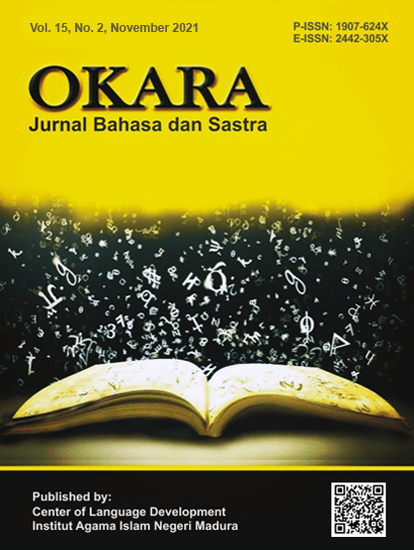The Searching for Self-Identity in Kazuo Ishiguro’s Never Let Me Go
 Abstract views: 3082
,
Abstract views: 3082
,
 PDF downloads: 1998
PDF downloads: 1998
Abstract
Self-identity is an aspect that every human in the world has. Without it, a person is in danger of being negatively affected by those around him/her and by the outside world. Some people are grappling with this identity-forming phase in their search for self-definition. This is reflected in Never Let Me Go by Kazuo Ishiguro. Therefore, this research aims to describe the main characters' search for self-identity as seen in the novel. The type of this research was library research. This research applied a psychological approach, and the data were analyzed using the descriptive qualitative method. The results showed that Kathy and Tommy's quest to find their true selves occurred in childhood, adolescence, and adulthood stages. Narrated by Kathy, she flashed back the memories of how they, Kathy and Tommy, are puzzled because of too many mysteries in Hailsham, the boarding school where they live. They connected each puzzle which could be the answer. But, in the novel, the question they belong to for being different brought them to another question. The process of findings itself flowed as long as they grew. In the end, they found information about their identity as a clone and as an individual.
Downloads
References
American Library Association. “2006 Alex Awards,” 2007. http://www.ala.org/yalsa/booklistsawards/bookawards/alexawards/alex06.
Carver, Charles S., and Michael F. Scheier. “Self-Focusing Effects of Dispositional Self-Consciousness, Mirror Presence, and Audience Presence.” Journal of Personality and Social Psychology 36, no. 3 (1978): 324–32. https://doi.org/10.1037/0022-3514.36.3.324.
Chatterjee, Arnab. “Exploring an Anti-Utopian Subtext in Kazuo Ishiguro’s Never Let Me Go.” Interdisciplinary Literary Studies 21, no. 2 (2019): 109–24. https://doi.org/10.5325/intelitestud.21.2.0109.
Gardner, Wendi L., Shira Gabriel, and Angela Y. Lee. “‘I’ Value Freedom, but ‘We’ Value Relationships: Self-Construal Priming Mirrors Cultural Differences in Judgment.” Psychological Science 10, no. 4 (1999): 321–26. https://doi.org/10.1111/1467-9280.00162.
Horowitz, Mardi. J. “Self-Identity Theory and Research Methods.” Journal of Research Practice 8, no. 2 (2012): 1–11.
Ishiguro, Kazuo. Never Let Me Go. London: Faber and Faber, 2010.
Kettle, Keri L., and Gerald Häubl. “The Signature Effect: Signing Influences Consumption-Related Behavior by Priming Self-Identity.” Journal of Consumer Research 38, no. 3 (2011): 474–89. https://doi.org/10.1086/659753.
Lewis, Michael and Jeanne Brooks-Gunn. Social Cognition and the Acquisition of Self. New York: Plenum, 1979. https://doi.org/10.1007/978-1-4684-3566-5.
Matthews, Sean, and Sebastian Groes. Kazuo Ishiguro: Contemporary Critical Perspectives. London: Continuum International Pub. Group, 2010.
Miller, Laura. Literary Wonderlands: A Journey through the Greatest Fictional Worlds Ever Created. London: Modern Books, 2017.
Nielsen, Mark, Thomas Suddendorf, and Virginia Slaughter. “Mirror Self-Recognition beyond the Face.” Child Development 77, no. 1 (2006): 176–85. https://doi.org/10.1111/j.1467-8624.2006.00863.x.
Oyserman, Daphna. “Self-Concept and Identity.” In Intraindividual Processes, edited by Abraham Tesser and Norbert Schwarz, 499–517. Malden, MA: Blackwell Publishers, 2001.
Oyserman, Daphna, Kristen Elmore, and George Smith. “Self, Self-Concept, and Identity.” In Handbook of Self and Identity, edited by Mark R. Leary and June Price, 69-104. New York: Guilford Press, 2012.
Oyserman, Daphna, and Leah James. “Handbook of Identity Theory and Research.” In Handbook of Identity Theory and Research, edited by & V. L. Vignoles S. J. Schwartz, K. Luyckx, 117–45. Springer Science + Business Media, 2011. https://doi.org/10.1007/978-1-4419-7988-9.
Simon, Linda, Jeff Greenberg, Eddie Harmon-Jones, Tom Pyszczynski, Sheldon Solomon, Jamie Arndt, and Teresa Abend. “Terror Management and Cognitive-Experiential Self-Theory: Evidence That Terror Management Occurs in the Experiential System.” Journal of Personality and Social Psychology 72, no. 5 (1997): 1132–46. https://doi.org/10.1037/0022-3514.72.5.1132.
Skripka, Taufik Wahyu. “Kathy H’s Struggle For Getting True Love In Kazuo Ishiguro’s Never Let Me Go Novel (2005) : An Individual Psychological Approach.” Universitas Muhammadiyah Surakarta, 2014.
Subhan, Bustami. A Guide to Literary Criticism. Yogyakarta: LPPDMF, 2015.
Sui, Jie, and Shihui Han. “Self-Construal Priming Modulates Neural Substrates of Self-Awareness.” Psychological Science 18, no. 10 (2007): 861–66. https://doi.org/10.1111/j.1467-9280.2007.01992.x.
“The Nobel Prize in Literature 2017,” 2017. https://www.nobelprize.org/prizes/literature/2017/summary/.
Trafimow, David, Harry C. Triandis, and Sharon G. Goto. “Some Tests of the Distinction Between the Private Self and the Collective Self.” Journal of Personality and Social Psychology 60, no. 5 (1991): 649–55. https://doi.org/10.1037/0022-3514.60.5.649.
Vichiensing, Matava. “The Othering in Kazuo Ishiguro’s Never Let Me Go.” Advances in Language and Literary Studies 8, no. 4 (2017): 126–35. https://doi.org/10.7575/aiac.alls.v.8n.4p.126.
Wellek, Rene, and Austin Warren. Theory of Literature. Harmondsworth: Penguin Books, 1963.
Yeung, Virginia. “Mortality and Memory in Kazuo Ishiguro’s Never Let Me Go.” Transnational Literature 9, no. 2 (2017): 1–13. https://doaj.org/article/d583068eff424a06853bde278f5c4bcc.
The journal operates an Open Access policy under a Creative Commons Attribution-NonCommercial 4.0 International License. Authors who publish with this journal agree to the following terms:
- Authors retain copyright and grant the journal right of first publication with the work simultaneously licensed under a Creative Commons Attribution License that allows others to share the work with an acknowledgement of the work's authorship and initial publication in this journal.
- Authors are able to enter into separate, additional contractual arrangements for the non-exclusive distribution of the journal's published version of the work (e.g., post it to an institutional repository or publish it in a book), with an acknowledgement of its initial publication in this journal.
- Authors are permitted and encouraged to post their work online (e.g., in institutional repositories or on their website) prior to and during the submission process, as it can lead to productive exchanges, as well as earlier and greater citation of published work.





_(1).png)
.png)
.png)
1.png)
.png)
.png)

.png)
_-_Copy_-_Copy.png)





